-
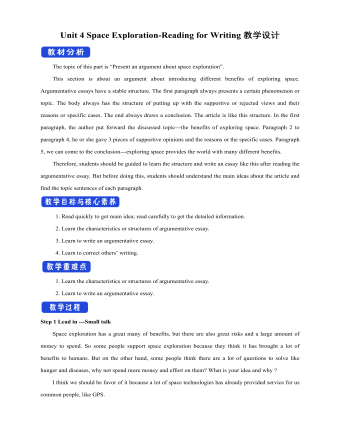
新人教版高中英语必修3Unit 4 Space Exploration-Reading for Writing教学设计二
⑦在我看来, 探索太空是值得的。As far as I am concerned, it is worthwhile to explore the space.Step 10 Writing---draftRecently, students in our class have had heated a discussion on whether space is worth exploring. Students hold different ideas about it.30% of us think space exploration is not worthwhile. They think space is too far away from us and our daily life and is a waste of money. And the money spent on space exploration can be used to solve the earth’s problems such as starvation and pollution.On the other hand,70% think space is worth exploring because we have benefited a lot from it,such as using satellites for communication and weather forecast. What’s more,with further space research,we may solve the population problem by moving to other planets one day. Also,space research will enable us to find new sources to solve the problem of energy shortages on the earth.As far as I am concerned, it is worthwhile to explore the space. Not only can it promote the development of society but also enrich our life. Step 11 Pair workExchange drafts with a partner. Use this checklist to help your partner revise his/her draft.1.Does the writer explain why he/she changed/wanted to change?2.Does the writer tell how the changes have improved or will improve his/her life?3.Is the text well-organised?4.Does the writer use words and expressions to show similarities and differences?5.Are there any grammar or spelling errors?6.Does the writer use correct punctuation?
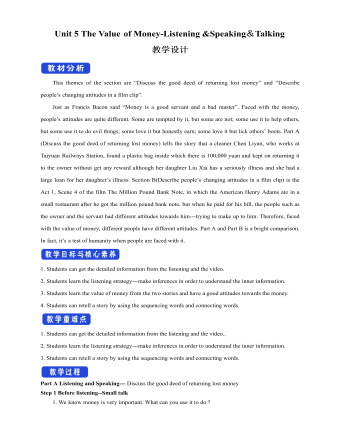
新人教版高中英语必修3Unit 5 The Value of Money-Listening &Speaking&Talking教学设计
4. A:We’d like to have someone to say a word at the beginning to welcome the group.B:↙Who?A:We thought that you or Dr.Johnson might do it.B用降调说Who,其意思是问,对方想让谁在开场时致欢迎词。Step 6 Pronunciation---Practice1. Listen to the short conversation and mark the intonation with ↗, ↙ or ↙, ↗. Then discuss with a partner what they intend to convey by using different intonation.Owner: You know what ?↗ It’s a million-pound bank note↙.Waiter 1: Really ?↗(question)Waiter 2: Really !↙(unbelievable and surprised)Waiter 3: Really ?!↙↗(first question then surprised)2. Listen to the conversations. Underline the parts that are stressed and mark the intonation. Then talk about the implied meanings of the responses with different intonations. Listen again and repeat.1) Henry: It’s a nice suit.Owner: Oh, it’s perfect!↙(The intonation means it is very suitable for Henry.)2) Henry: Well, that’s very kind of you.Owner: Kind, sir ?↗(what you said is not right) No, it’s kind of you. You must come whenever you want and have whatever you like. Just having you sit here is a great honour !!↙(welcome you to come again)3)Henry:Well, to be honest, I have none. Oliver:(happily) What luck!(excited) Brother↗, what luck!↙(It means “Didn’t you hear it?”)Henry: Well, it may seem lucky to you but not to me!↗(angry) If this is your idea of some kind of joke, I don’t think it’s very funny. Now if you’ll excuse me, I ought to be on my way.↙(If so, I would leave.)Roderick: Please don’t go↙...(hope Henry can wait for a moment)Part B Viewing and Talking---Describe people’s changing attitudes in a film clipStep 1 Before-listening---Tell the filmYou are going to watch part of the film The Million Pound Bank Note. Look at these photos and guess what happens in the film.
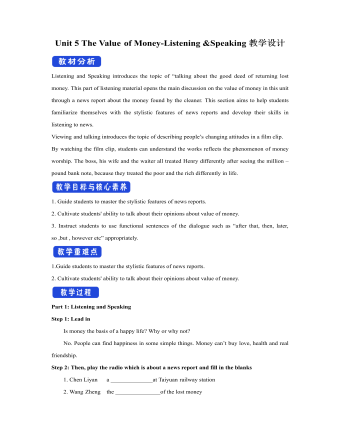
新人教版高中英语必修3Unit 5 The Value of Money-Listening &Speaking教学设计
Step 4: Listen again and decide if the following statements are true (T) or false (F).1 It was the first time Chen Liyan's story was reported. T口 F口2 Chen found 10,000 yuan in a small plastic bag in Taiyuan railway station口 F口3 Wang Zheng apologized to Chen because he couldn't offer her more money. T口 F口4 Chen took out a large loan to cure her daughter, T口 F口5 Wang set up a fundraising website for Chen's daughter after Chen told him about her situation. T口 F口Step 5:After listening, discuss the questions.1 What kind of person do you think Chen Liyan is?Chen Liyan is generous and honest because she returned a large sum of money to the owner.2 Did Chen return the money because she didn't need it?No. She returned the money because it was the right thing to do. Evidence for this is that she refused to accept the reward money because she felt that it had not been earned. 3 Is it common for people to do what Chen did?It depends on the culture. In some countries it is quite common to return money that has been found. In other countries, people believe "Finders are keepers!" 4 How did Wang Zheng feel about the return of his money?He must have been very happy and relieved to have gotten his money back. We know this because he thanked Chen repeatedly and even offered her a reward.5 Why did Ma Dongbao tell Wang about Chen's family?He must have had great sympathy for Chen and her daughter and wanted to help them.'We know this because he arranged help for them. 6 How did the news reporter feel about Chen's actions?The news reporter felt that it showed that money wasn't the most important thing in life. We know this because the reporter told us that this is what Chen believes. and then said, “that's a great attitude to take."
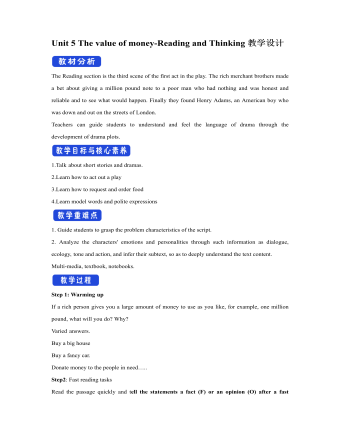
新人教版高中英语必修3Unit 5 The value of money-Reading and Thinking教学设计二
? Could you offer me some kind of work here?? I don’t want your charity, I just want an honest job.? Careless: I landed in Britain by accident.Step 7:Consolidation.? Find Henry? Roderick and Oliver were I .making a bet when they saw Henry, a poor young man. ? Know Henry? About a month ago, Henry was sailing and later he found himself carried out to sea by a strong wind. Fortunately, he 2.was spotted by a ship. And it was the ship that brought him to 3.England? Offer money to Henry ? Oliver and Roderick gave Henry a letter and told him that there was money in it. They 4.persuaded him to accept it, and made him 5.promise that it wouldn't be opened until 2 o'clock.Step 8:Language pointsa large amount of: a large quantity of; a great deal ofe.g. They bought a large amount of furniture before they moved their new house.make a bet: make an arrangement to risk money, etc. on an event of which the result is doubtful.e.g. We made a bet on the result of the match.permit sb to do something: allow somebody to do somethinge.g. My mother doesn’t permit me to ride in the street after it rained.by accident: as a result of chancee.g. I only found it by accident.stare at: look at somebody or something with the eyes wide open in a fixed gaze( in astonishment, wonder, fear, etc)to be honest: to tell you the truth; to be franke.g. To be honest, I don’t think we have a chance of winning.Step7 Homework:What do you think will happen to Henry? Will the bank-note help him or get him into trouble?
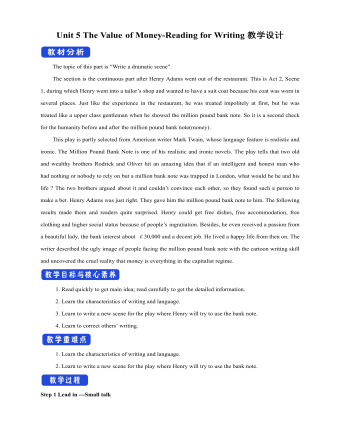
新人教版高中英语必修3Unit 5 The Value of Money-Reading for Writing教学设计二
2. 您能看到, 我头发太长了。You can see that my hair is much too long.3. 无论什么时候, 只要您想回来就回来。Please come back whenever you want.4. 您仅有很少的头发要理! You only have too little hair to cut !5. 为您服务是我的荣幸!It is my honour to serve you!Step 9 Writing(Henry is walking down the street when he sees a sign for a place that cuts hair. He decides to have it cut. )H=Henry B=BarberH: Good afternoon, I’d like to have my hair cut, if I may. (The barber looks at Henry’s hair and continues cutting another man’s hair. ) Er, I’d really like a haircut. As you can see it’s much too long. B: (in a rude manner) Yes, I can see that. Indeed, I can. H: Fine, well, I’ll have a seat then. (He sits in one of the barber’s chairs. The barber turns to look at Henry. )B: It’s quite expensive here, you know! Are you sure you can afford it?H: Yes. I think so. (After his hair is cut, the barber tells Henry how much he must pay. Henry shows the barber the bank note. )B: Why Mr. . . (looks shocked)H: Adams. Henry Adams. I’m sorry. I don’t have any change. B: Please don’t worry! (wearing a big smile) Nothing to worry about! Nothing at all! Please come back whenever you want, even if you only have too little hair to cut! It will be my honour to serve you!Step 10 Pair workExchange drafts with a partner. Use this checklist to help your partner revise his/her draft.1. Are all the elements of a play included and in good order ?2. Do the character use suitable language ?3. Are the stage directions clear and useful ?4. Is the plot clear and exciting enough ?
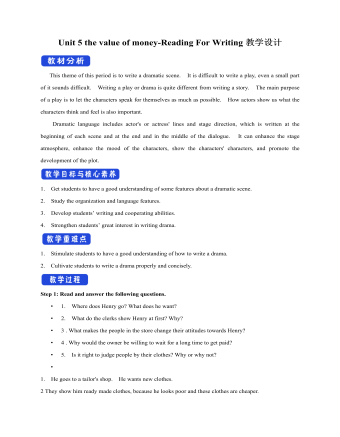
新人教版高中英语必修3Unit 5 the value of money-Reading For Writing教学设计一
【参考范文】Narrator:(Henry is smiling as he leaves the restaurant. As he is walking down the street, he sees a sign for a place that cuts hair. He decides to get it cut. )H=Henry;B=Barber;R=rude manH:Good afternoon, I'd like to get a cut, if I may. (The barber looks at Henry's hair and continues cutting another man's hair. )Er, I'd really like a haircut. As you can see it's much too long. B:(in a rude manner) Yes, I can see that. Indeed, I can. H:Fine, well I'll have a seat then. (He sits in one of the barber's chairs. The barber turns to look at Henry. )B:It's quite expensive here, you know!Are you sure you can afford it?H:Yes. I think so. (In comes the rude man. )R:Hey you there. I need a haircut quickly. Can you do me straightaway?B:All right, then, get in the chair and I'll see what I can do. R:Thank you. (sits down in one of the barber's chairs)H:Excuse me, but I was here first. Aren't you going to do my hair first?B:This man's in a hurry. H:Well so am I!I insist that you cut my hair first. B:OK, but I'll have to be quick. This gentleman is waiting. H:Thank you. (They both become quiet. After his hair is cut, the barber tells Henry how much he must pay. Henry shows the barber the bank note. )B:Why, Mr . . . (looks shocked)H:Adams. Henry Adams. I'm sorry, I don't have any change. R:You're that Mr Adams! Well,I'm glad I waited or I might never have known it was you. B:Why, Mr Adams, please don't worry!(wearing a big smile) Nothing to worry about!Nothing at all!Please come back any time, even if you only need too little hairs cut!It will be my honour to serve you!
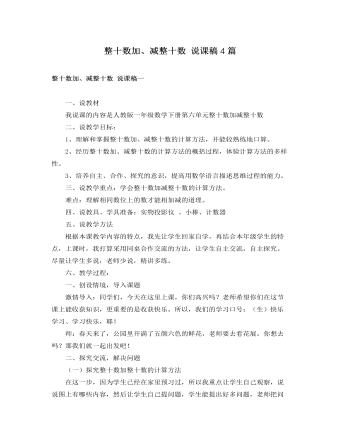
人教版新课标小学数学一年级下册整十数加、减整十数 说课稿4篇
2、教材分析整十数加、减整十数的计算是在10以内加、减法的基础上进行的,只是计数单位不同,这里以十为计数单位。教学内容的编排,分三个层次:一、以实际情景——花卉展提供计算题,并呈现算法的多样化;二、让学生动手操作(如摆小棒)理解算理、掌握算法;三、脱离直观手段,让学生思考算法。通过让学生在生动具体的情境中学习计算,引导学生独立思考与合作交流多种不同的算法,进一步培养计算能力。这样安排,有助于学生加深对相同单位的数可以直接相加、减的认识,为后面学习任意两个数相加、减打基础。整十数加、减整十数属于计算教学中的重点内容之一,应给予足够的重视。教材的编排是由直观操作等依靠实物思考到脱离实物思考,遵循由具体到抽象的原则,有利于学生抽象思维的培养,为进一步提高计算速度、培养计算能力,解决实际问题打基础。

人教版高中历史必修3西方人文主义思想的起源说课稿
苏格拉底把装有毒酒的杯子举到胸口,平静地说:“分手的时候到了,我将死,你们活下来,是谁的选择好,只有天知道。”说毕,一口喝干了毒酒。(2) 苏格拉底临死前对一个叫克力同的人说了这样一番话。克力同,我告诉你,这几天一直有一个神的声音在我心中晓喻我,他说:“苏格拉底,还是听我们的建议吧,我们是你的卫士。不要考虑你的子女、生命或其他东西胜过考虑什么是公正。……事实上你就要离开这里了。当你去死的时候,你是个牺牲品,但不是我们所犯错误的牺牲品,而是你同胞所犯错误的牺牲品。但你若用这种可耻的方法逃避,以错还错,以恶报恶,践踏你自己和我们订立的协议合约,那么你伤害了你最不应该伤害的,包括你自己、你的朋友、你的国家,还有我们。到那时,你活着面对我们的愤怒,你死后我们的兄弟、冥府里的法律也不会热情欢迎你;因为它们知道你试图尽力摧毁我们。别接受克力同的建议,听我们的劝告吧。”
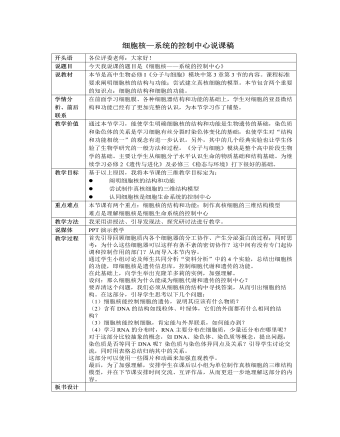
人教版高中生物必修1细胞核—系统的控制中心说课稿
首先引导回顾细胞质内各个细胞器的分工协作、产生分泌蛋白的过程;同时思考:为什么这些细胞器可以这样有条不紊的密切协作?这中间有没有专门起协调和控制作用的部门?从而导入本节内容。通过学生小组讨论及师生共同分析“资料分析”中的4个实验,总结出细胞核的功能,即细胞核是遗传信息库,控制细胞代谢和遗传的功能。在此基础上,向学生举出克隆羊多莉的实例,加强理解。设问:那么细胞核为什么能成为细胞代谢和遗传的控制中心?要弄清这个问题,我们必须从细胞核的结构中寻找答案,从而引出细胞的结构。在这部分,引导学生思考以下几个问题:(1)细胞核能控制细胞的遗传,说明其应该有什么物质?(2)含有DNA的结构如线粒体、叶绿体,它们的外面都有什么相同的结构?(3)细胞核能控制细胞,肯定能与外界联系,如何能办到?(4)学习RNA的分布时,RNA主要分布在细胞质,少量还分布在哪里呢?
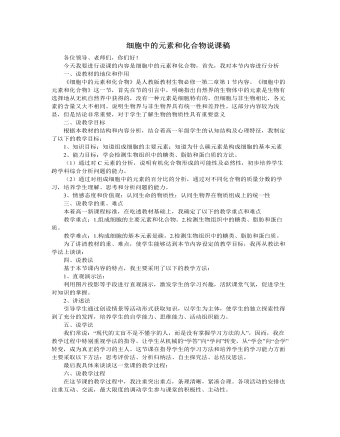
人教版高中生物必修1细胞中的元素和化合物说课稿
一、说教材的地位和作用《细胞中的元素和化合物》是人教版教材生物必修一第二章第1节内容。《细胞中的元素和化合物》这一节,首先在节的引言中,明确指出自然界的生物体中的元素是生物有选择地从无机自然界中获得的,没有一种元素是细胞特有的。但细胞与非生物相比,各元素的含量又大不相同。说明生物界与非生物界具有统一性和差异性。这部分内容较为浅显,但是结论非常重要,对于学生了解生物的物质性具有重要意义二、说教学目标根据本教材的结构和内容分析,结合着高一年级学生的认知结构及心理特征,我制定了以下的教学目标:1、知识目标:知道组成细胞的主要元素;知道为什么碳元素是构成细胞的基本元素2、能力目标:学会检测生物组织中的糖类、脂肪和蛋白质的方法。(1)通过对C元素的分析,说明有机化合物形成的可能性及必然性,初步培养学生跨学科综合分析问题的能力。(2)通过对组成细胞中的元素的百分比的分析,通过对不同化合物的质量分数的学习,培养学生理解、思考和分析问题的能力。
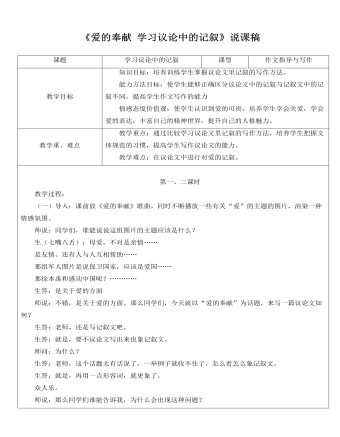
人教版高中语文必修3《爱的奉献 学习议论中的记叙》说课稿
教学过程:(一)导入:课前放《爱的奉献》歌曲,同时不断播放一些有关“爱”的主题的图片,渲染一种情感氛围。师说:同学们,谁能说说这组图片的主题应该是什么?生(七嘴八舌):母爱,不对是亲情……是友情、还有人与人互相帮助……那组军人图片是说保卫国家,应该是爱国……那徐本禹和感动中国呢?…………生答:是关于爱的方面师说:不错,是关于爱的方面。那么同学们,今天就以“爱的奉献”为话题,来写一篇议论文如何?生答:老师,还是写记叙文吧。生答:就是,要不议论文写出来也象记叙文。师问:为什么?生答:老师,这个话题太有话说了,一举例子就收不住了,怎么看怎么象记叙文。生答:就是,再用一点形容词,就更象了。众人乐。师说:那么同学们谁能告诉我,为什么会出现这种问题?一生小声说:还不是我们笨,不会写。师说:不是笨,也不是不会写,你们想为什么记叙文就会写,一到议论文就不会了,那是因为同学们没有明白议论文中的记叙与记叙文中的记叙有什么不同,所以一写起议论文中的记叙,还是按照记叙文的写法写作,这自然就不行了。那好,今天我们就从如何写议论文中的记叙讲起。
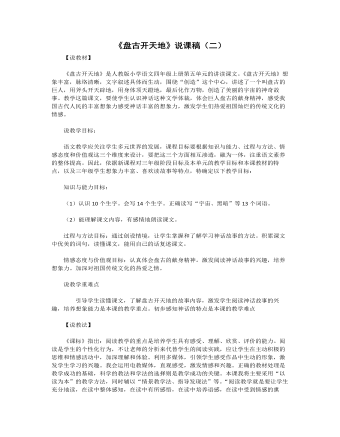
(新)部编人教版四年级上册《 盘古开天地》说课稿(二)
【说教材】《盘古开天地》是人教版小学语文四年级上册第五单元的讲读课文。《盘古开天地》想象丰富,脉络清晰,文字叙述具体而生动,围绕“创造”这个中心,讲述了一个叫盘古的巨人,用斧头开天辟地,用身体顶天蹬地,最后化作万物,创造了美丽的宇宙的神奇故事。教学这篇课文,要使学生认识神话这种文学体裁,体会巨人盘古的献身精神,感受我国古代人民的丰富想象力感受神话丰富的想象力,激发学生们热爱祖国灿烂的传统文化的情感。说教学目标:语文教学应关注学生多元世界的发展,课程目标要根据知识与能力、过程与方法、情感态度和价值观这三个维度来设计,要把这三个方面相互渗透,融为一体,注重语文素养的整体提高。因此,依据新课程对三年级阶段目标及本单元的教学目标和本课教材的特点,以及三年级学生想象力丰富、喜欢读故事等特点,特确定以下教学目标
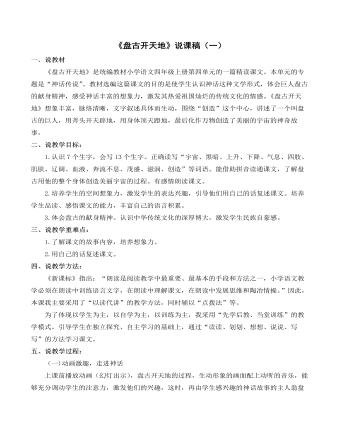
(新)部编人教版四年级上册《盘古开天地》说课稿(一)
结束后我再次引读:只听一声巨响,混沌一片的东西渐渐分开了。展开多媒体,学生读下半段“轻而清的东西,缓缓上升,变成了天;重而浊的东西,慢慢下降,变成了地。”这一环节是本段的重点,我打算分三步进行。第一步请学生来发现句子中的近义词和反义词;第二步理解两个清的区别;第三步指导朗读,朗读形式多种多样,可以师生配合,男女生合作、带动做朗读等等。在这天地分开之前,轻而清,重而浊的东西是一片混沌,再次理解“混沌”一词。告诉学生今后遇到不懂的词语还有一种方法就是结合上下文来理解。这一段上完之后再全班齐读一遍。 最后指导生字,重点指导“创造”,我在黑板上范写,指导个别笔画,留五分钟给学生写字。 (四)细读品味,感悟精神
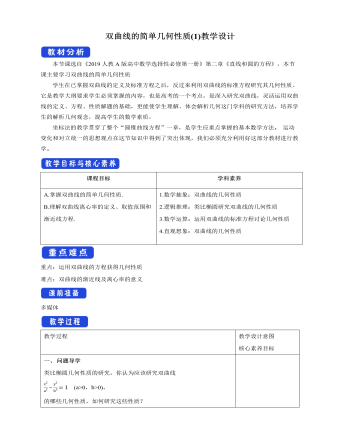
双曲线的简单几何性质(1)教学设计人教A版高中数学选择性必修第一册
问题导学类比椭圆几何性质的研究,你认为应该研究双曲线x^2/a^2 -y^2/b^2 =1 (a>0,b>0),的哪些几何性质,如何研究这些性质1、范围利用双曲线的方程求出它的范围,由方程x^2/a^2 -y^2/b^2 =1可得x^2/a^2 =1+y^2/b^2 ≥1 于是,双曲线上点的坐标( x , y )都适合不等式,x^2/a^2 ≥1,y∈R所以x≥a 或x≤-a; y∈R2、对称性 x^2/a^2 -y^2/b^2 =1 (a>0,b>0),关于x轴、y轴和原点都是对称。x轴、y轴是双曲线的对称轴,原点是对称中心,又叫做双曲线的中心。3、顶点(1)双曲线与对称轴的交点,叫做双曲线的顶点 .顶点是A_1 (-a,0)、A_2 (a,0),只有两个。(2)如图,线段A_1 A_2 叫做双曲线的实轴,它的长为2a,a叫做实半轴长;线段B_1 B_2 叫做双曲线的虚轴,它的长为2b,b叫做双曲线的虚半轴长。(3)实轴与虚轴等长的双曲线叫等轴双曲线4、渐近线(1)双曲线x^2/a^2 -y^2/b^2 =1 (a>0,b>0),的渐近线方程为:y=±b/a x(2)利用渐近线可以较准确的画出双曲线的草图
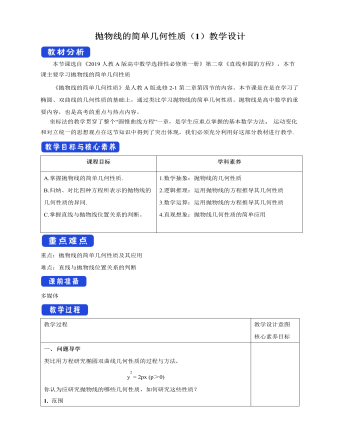
抛物线的简单几何性质(1)教学设计人教A版高中数学选择性必修第一册
问题导学类比用方程研究椭圆双曲线几何性质的过程与方法,y2 = 2px (p>0)你认为应研究抛物线的哪些几何性质,如何研究这些性质?1. 范围抛物线 y2 = 2px (p>0) 在 y 轴的右侧,开口向右,这条抛物线上的任意一点M 的坐标 (x, y) 的横坐标满足不等式 x ≥ 0;当x 的值增大时,|y| 也增大,这说明抛物线向右上方和右下方无限延伸.抛物线是无界曲线.2. 对称性观察图象,不难发现,抛物线 y2 = 2px (p>0)关于 x 轴对称,我们把抛物线的对称轴叫做抛物线的轴.抛物线只有一条对称轴. 3. 顶点抛物线和它轴的交点叫做抛物线的顶点.抛物线的顶点坐标是坐标原点 (0, 0) .4. 离心率抛物线上的点M 到焦点的距离和它到准线的距离的比,叫做抛物线的离心率. 用 e 表示,e = 1.探究如果抛物线的标准方程是〖 y〗^2=-2px(p>0), ②〖 x〗^2=2py(p>0), ③〖 x〗^2=-2py(p>0), ④
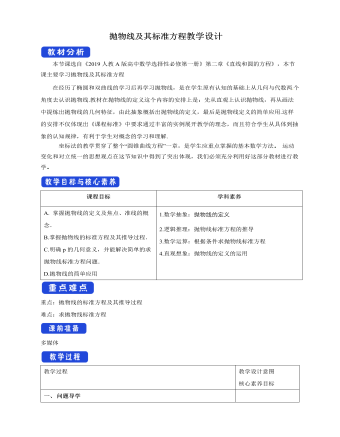
抛物线及其标准方程教学设计人教A版高中数学选择性必修第一册
本节课选自《2019人教A版高中数学选择性必修第一册》第二章《直线和圆的方程》,本节课主要学习抛物线及其标准方程在经历了椭圆和双曲线的学习后再学习抛物线,是在学生原有认知的基础上从几何与代数两 个角度去认识抛物线.教材在抛物线的定义这个内容的安排上是:先从直观上认识抛物线,再从画法中提炼出抛物线的几何特征,由此抽象概括出抛物线的定义,最后是抛物线定义的简单应用.这样的安排不仅体现出《课程标准》中要求通过丰富的实例展开教学的理念,而且符合学生从具体到抽象的认知规律,有利于学生对概念的学习和理解.坐标法的教学贯穿了整个“圆锥曲线方程”一章,是学生应重点掌握的基本数学方法 运动变化和对立统一的思想观点在这节知识中得到了突出体现,我们必须充分利用好这部分教材进行教学
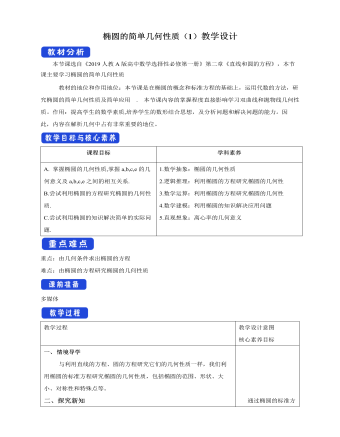
椭圆的简单几何性质(1)教学设计人教A版高中数学选择性必修第一册
1.判断 (1)椭圆x^2/a^2 +y^2/b^2 =1(a>b>0)的长轴长是a. ( )(2)若椭圆的对称轴为坐标轴,长轴长与短轴长分别为10,8,则椭圆的方程为x^2/25+y^2/16=1. ( )(3)设F为椭圆x^2/a^2 +y^2/b^2 =1(a>b>0)的一个焦点,M为其上任一点,则|MF|的最大值为a+c(c为椭圆的半焦距). ( )答案:(1)× (2)× (3)√ 2.已知椭圆C:x^2/a^2 +y^2/4=1的一个焦点为(2,0),则C的离心率为( )A.1/3 B.1/2 C.√2/2 D.(2√2)/3解析:∵a2=4+22=8,∴a=2√2.∴e=c/a=2/(2√2)=√2/2.故选C.答案:C 三、典例解析例1已知椭圆C1:x^2/100+y^2/64=1,设椭圆C2与椭圆C1的长轴长、短轴长分别相等,且椭圆C2的焦点在y轴上.(1)求椭圆C1的半长轴长、半短轴长、焦点坐标及离心率;(2)写出椭圆C2的方程,并研究其性质.解:(1)由椭圆C1:x^2/100+y^2/64=1,可得其半长轴长为10,半短轴长为8,焦点坐标为(6,0),(-6,0),离心率e=3/5.(2)椭圆C2:y^2/100+x^2/64=1.性质如下:①范围:-8≤x≤8且-10≤y≤10;②对称性:关于x轴、y轴、原点对称;③顶点:长轴端点(0,10),(0,-10),短轴端点(-8,0),(8,0);④焦点:(0,6),(0,-6);⑤离心率:e=3/5.
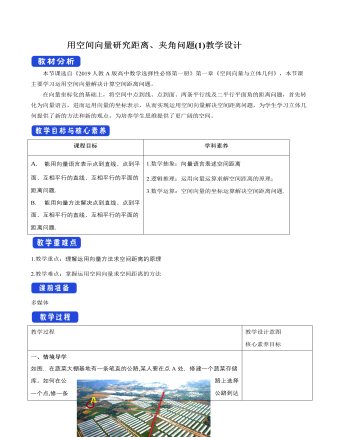
用空间向量研究距离、夹角问题(1)教学设计人教A版高中数学选择性必修第一册
二、探究新知一、点到直线的距离、两条平行直线之间的距离1.点到直线的距离已知直线l的单位方向向量为μ,A是直线l上的定点,P是直线l外一点.设(AP) ?=a,则向量(AP) ?在直线l上的投影向量(AQ) ?=(a·μ)μ.点P到直线l的距离为PQ=√(a^2 "-(" a"·" μ")" ^2 ).2.两条平行直线之间的距离求两条平行直线l,m之间的距离,可在其中一条直线l上任取一点P,则两条平行直线间的距离就等于点P到直线m的距离.点睛:点到直线的距离,即点到直线的垂线段的长度,由于直线与直线外一点确定一个平面,所以空间点到直线的距离问题可转化为空间某一个平面内点到直线的距离问题.1.已知正方体ABCD-A1B1C1D1的棱长为2,E,F分别是C1C,D1A1的中点,则点A到直线EF的距离为 . 答案: √174/6解析:如图,以点D为原点,DA,DC,DD1所在直线分别为x轴、y轴、z轴建立空间直角坐标系,则A(2,0,0),E(0,2,1),F(1,0,2),(EF) ?=(1,-2,1),

用空间向量研究直线、平面的位置关系(1)教学设计人教A版高中数学选择性必修第一册
二、探究新知一、空间中点、直线和平面的向量表示1.点的位置向量在空间中,我们取一定点O作为基点,那么空间中任意一点P就可以用向量(OP) ?来表示.我们把向量(OP) ?称为点P的位置向量.如图.2.空间直线的向量表示式如图①,a是直线l的方向向量,在直线l上取(AB) ?=a,设P是直线l上的任意一点,则点P在直线l上的充要条件是存在实数t,使得(AP) ?=ta,即(AP) ?=t(AB) ?.如图②,取定空间中的任意一点O,可以得到点P在直线l上的充要条件是存在实数t,使(OP) ?=(OA) ?+ta, ①或(OP) ?=(OA) ?+t(AB) ?. ②①式和②式都称为空间直线的向量表示式.由此可知,空间任意直线由直线上一点及直线的方向向量唯一确定.1.下列说法中正确的是( )A.直线的方向向量是唯一的B.与一个平面的法向量共线的非零向量都是该平面的法向量C.直线的方向向量有两个D.平面的法向量是唯一的答案:B 解析:由平面法向量的定义可知,B项正确.

空间向量及其运算的坐标表示教学设计人教A版高中数学选择性必修第一册
一、情境导学我国著名数学家吴文俊先生在《数学教育现代化问题》中指出:“数学研究数量关系与空间形式,简单讲就是形与数,欧几里得几何体系的特点是排除了数量关系,对于研究空间形式,你要真正的‘腾飞’,不通过数量关系,我想不出有什么好的办法…….”吴文俊先生明确地指出中学几何的“腾飞”是“数量化”,也就是坐标系的引入,使得几何问题“代数化”,为了使得空间几何“代数化”,我们引入了坐标及其运算.二、探究新知一、空间直角坐标系与坐标表示1.空间直角坐标系在空间选定一点O和一个单位正交基底{i,j,k},以点O为原点,分别以i,j,k的方向为正方向、以它们的长为单位长度建立三条数轴:x轴、y轴、z轴,它们都叫做坐标轴.这时我们就建立了一个空间直角坐标系Oxyz,O叫做原点,i,j,k都叫做坐标向量,通过每两个坐标轴的平面叫做坐标平面,分别称为Oxy平面,Oyz平面,Ozx平面.